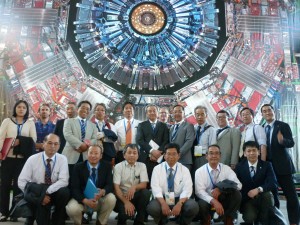 The Japanese town Kesen-Numa has large expertise in the fishing and port industry, but they have never hosted a major international lab. A delegation recently visited CERN to learn how these labs work, what they need and what benefit they bring to their neighbours.
The Japanese town Kesen-Numa has large expertise in the fishing and port industry, but they have never hosted a major international lab. A delegation recently visited CERN to learn how these labs work, what they need and what benefit they bring to their neighbours.
Their visit included a trip to the site of the CMS detector, where a huge cavern was excavated to house the detector some 100 metres underground. The excavated rock was piled up into two hills that are now overgrown with grass, shrubs and trees, and a little water reservoir of water extracted from the cavern air has become the home for insects, toads and some families of ducks. A walking path leads around the CMS site, the hills and the pond and is a favourite running and dog-walking spot for locals. As CMS site manager Martin Gastal from CERN points out, all this was planned and realised in close cooperation with the neighbouring villages. CMS also cooperates with the local tourist information and reserves visit slots for locals and for tourist in order to build and keep the trust of the neighbours. To Kesen-Numa mayor Shigeru Sugawara this was a major lesson: “Seeing high-tech in such harmony with the environment was most impressive,” he said.
Kesen-Numa would be the arrival and assembly place for many crucial parts of the future ILC and a home for many of the researchers and hopes that its industry will play a major role in the science project. “We cannot do it all, but with the collaboration of many it can be done,” says Sugawara. “First we need to convince the Japanese government.”
Host and visit organiser Akira Yamamoto also reports on the visit in the Director’s Corner of this issue. Delegation Kesen-Numa, quote from mayor, community work CMS, etc.

Recent Comments